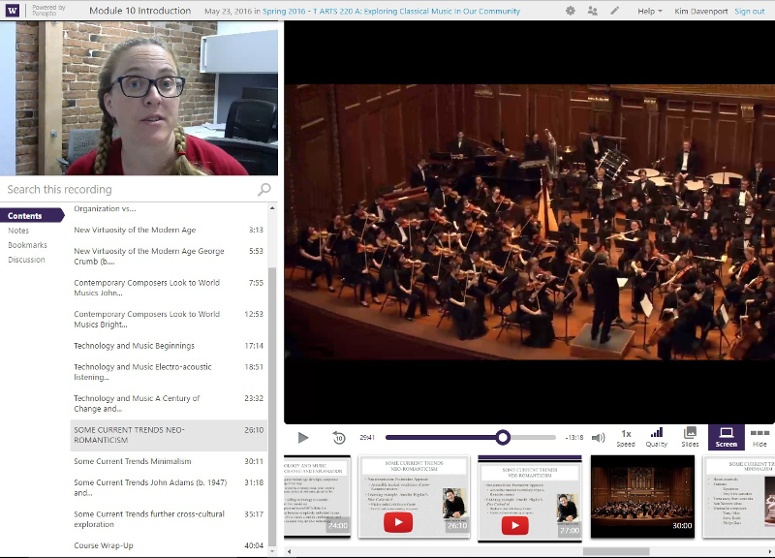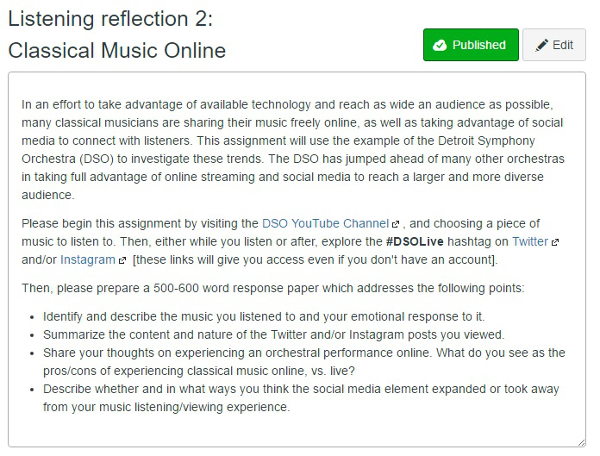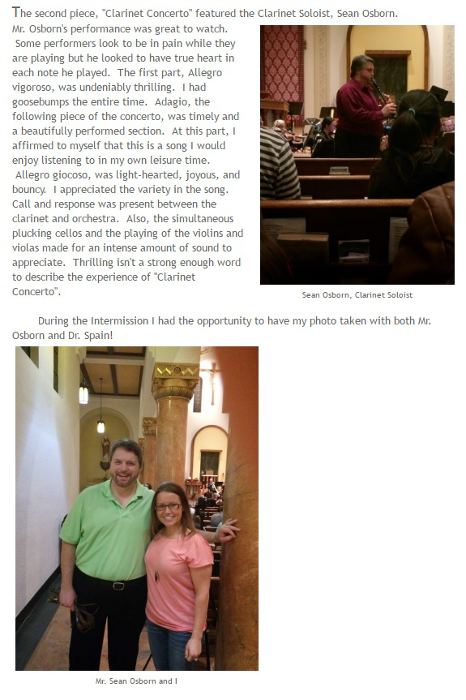Abstract
This article describes the creation and delivery of a fully-online music appreciation courses for the University of Washington, Tacoma (UWT), entitled “Exploring Classical Music in our Community.” While inspired by a pragmatic need to provide more introductory humanities courses online for a busy, diverse, non-traditional student body, the new course has revealed that online delivery of music appreciation content can provide solutions to pedagogical challenges.
Background
The University of Washington, Tacoma, founded in 1990, is an urban-serving university, located in the heart of downtown Tacoma, Washington. Initially, the campus served only upper-division and graduate students. In 2006, the campus began admitting lower-division students, which led to both the development of a broader range of curricular offerings, as well as a rapid increase in the size of the student body (currently about 5,000).
UWT is an urban commuter campus which serves a diverse population. The following describes the dimensions of this diversity: (1) majority of first generation college students; (2) majority of students working at least part time while in school, (3) a broad range of ethnic backgrounds, including many who are recent immigrants; and, (4) given UWT’s proximity to Joint Base Lewis-McChord, many students are active-duty military personnel or their families.
I have taught music courses at UWT, in a traditional classroom format, since 2007. While these classes have been successful in terms of both student ratings and in meeting campus student learning objectives for lower-division humanities courses, I have encountered pedagogical challenges along the way which are described below. Although skeptical at first about online course delivery, I have found some solutions to these challenges by using the online teaching environment.
Course Design
Supported by an institutional push to offer more online courses to serve our students, I enrolled in a faculty development workshop during the summer of 2014 which provided both the necessary tools and institutional approval to develop new online courses.
It was during this workshop, proudly wearing my skepticism on my sleeve, that a colleague shared her mantra: “Anything you can do in the classroom, you can do online, just not the same way.” This was the inspiration for me to let my defenses down, roll up my sleeves, and think seriously about how perhaps the online environment could expand my pedagogy in ways that would help me reach students more effectively (Blackburn & McGrath, (2014); Moccozet, Tardy, Lakhdar, Lakhdar, Rentsch, & Wirth, M. (2013). Choosing to see the technology as a tool, rather than as a barrier to face-to-face interaction, I confronted the challenges I had found with my existing courses.
My first challenge was that in a classroom setting, those students who had some previous background in music could overwhelm those who did not, resulting in a lack of participation on the part of the less confident students. One of my first decisions was that in the online environment, I would relate to students on a 1-to-1 basis. I would not require them to post and respond to one another’s discussion board posts, as happens in many online courses; rather, assessment would be based on frequent, short reflective papers to which I could give individualized feedback. Course design would also take advantage of the fact that, in the online environment, students could listen to a musical example as many times as they felt necessary to understand the concepts under discussion.
The second challenge I chose to confront was that of how to provide affordable, accessible concert attendance experiences. Given that UWT does not have a music department that provides regular on-campus performances, I typically ask my students to attend concerts elsewhere in the community. The cost and time commitment of this requirement a burden for many of our students. They simply choose not to attend any concerts, thus missing out on valuable learning experiences. The online environment provides a solution: placing lecture and assignment content online allows students increased flexibility over a fixed in-class lecture time. In turn, students become more willing to make arrangements to attend concerts, thus dramatically increasing their engagement with the course material.
After a few months of work, I created two new courses which were taught for the first time during the 2014-15 academic year. The first was a standard course of its type, simply offered in an online environment. The second, called T ARTS 220: “Exploring Classical Music in our Community,” with its more unique design, has proven particularly successful and highly replicable. It is this course that I highlight here.
I designed T ARTS 220 as an online version of the concert-attendance seminars which are offered by many college music departments. Instead of attending a lecture and then an on-campus concert as in that traditional model, I planned for UWT students to utilize online readings, video lectures, and audio examples, and then attend concerts in our community.
Over a 10-week quarter, the student progresses through weekly video lectures with accompanying quizzes. Lecture topics included:
1. Skill development in the areas of listening to and writing about music,
2. Introduction to the classical music scene in Tacoma (venues, ensembles, etc.), and
3. Survey of the history of Western concert music.
The course was initially designed around a music appreciation textbook, but in the interest of cost savings, I eliminated the book and replaced it with self-designed lectures supplemented by audio/visual material from both freely-available sources such as YouTube, as well as subscription sources available through the UWT Library, primarily the NAXOS Music Library. Using the lecture-capture software Panopto I am able to share with students a single presentation which includes PowerPoint slides, video of my accompanying lecture, as well as musical examples (see Example 1).

Example 1
In addition, three short papers which invite students to analyze current issues in the world of classical music are distributed throughout the quarter (see Example 2). Carefully selected TED Talks and audio/video examples of current musical activities around the nation and the world bring the global scene to a local level and help the students to feel part of something larger than just this one course.

Example 2
Students are then required to attend four concerts at any time during the quarter, and create a blog to share their reflections about these concert attendance experiences. Students may choose to make their blogs public (appealing to Communication students, for example, who wish to hone and display such skills) or private (for those students who thrive on the one-to-one relationship). The blogs also include bookend posts, in which students describe where they start and end the quarter in terms of musical experiences. Blogging allows for students to include photographs, audio/video files, and links in their posts, leading to much more engaging reflections than a simple paper (see Example 3).

Example 3
One of the four concerts can be a live online broadcast but at least three must be attended live. This provides more flexibility for students. Since many begin the quarter unfamiliar with how to locate classical concerts, I provide a calendar of approved concerts. Events are selected from professional, amateur, and collegiate performances in our community. The calendar provides students dozens of options in a wide variety of venues. Interestingly, students often express surprise at the range of classical music concerts available in the Tacoma area.
Although I remain committed to the concept of reaching my students on a one-to-one basis, I also understand that there may be those who miss the opportunity to interact with peers. For this reason, I have added a few elements to the course that enable this type of interaction without requiring it. For example, I provide a discussion board for students to make arrangements to attend concerts together if they so choose. For those who enjoy social media interaction, I encourage the use of hashtags like #MusicUWT, to share posts and pictures from concert attendance experiences (see Example 4). Finally, UWT’s quarterly ‘Student Showcase’ provides a public presentation opportunity for those students interested in sharing more widely what they have learned.

Example 4
Outcomes
While confident in the design of the course, I have been amazed by its success in helping students move past the challenges I mentioned above. When freed from the schedule restraints of a traditional class, students find it more realistic to attend concerts. Rather than hearing from a few talkative students in an otherwise silent classroom, I am able to work individually with each student, validating their starting point with the material, wherever that might be. Given the opportunity to blog, rather than write formal academic papers, students share powerful stories about including their children in their learning experience, attending events at venues in which they did not previously feel welcome because of socio-economic status, and their emotional reactions to the music itself. More often than not, this course provides students with their first experience attending a live classical music concert. The following excerpts from students’ blog posts speak to these themes:
“What I have gained from this class is not something that can be measured. It's expansive, has depth and is intangible. My personal key take-away is the revelation on the importance of experience. Music is performed for all. It provides a sense of community. Music is an outlet that strengthens social capital and allows for personal interaction with people from diverse walks of life. The differences in others may seem intimidating but there is a common interest among the people you meet there. That common interest is the appreciation of experiencing music.”
--
“One major thing I will take from this class is teaching what I have learned to my children. As soon as I graduate (this June) and find a job, I want them to play an instrument if they are interested. … This class has reminded me that I also wanted to go watch more concerts in our community. You would wonder how one could forget that, but being a single parent and a full time student, I'm capable of forgetting anything.”
--
“I actually thoroughly enjoyed going out to concerts and immersing myself in a culture that I would not have done otherwise. I'm by no means an expert on classical music, but I have grown an appreciation for the genre. … Being able to see that there are musicians and performers of all ages in this area who have a passion for this type of music was really neat, and instead of perceiving that type of music as "dying out", I see that it is still alive and well.”
--
“It’s not hard to say which performance was the most impactful for us, it absolutely had to be Peter and the Wolf by the Tacoma Symphony … because my whole family decided to start playing instruments after that show. … I am so thankful for this class. It has taught my children and I how to enjoy live concerts and classical music.”
--
“I always thought that classical music was primarily for the affluent which turned me off because I felt that it was not inclusive. However, after attending concerts and reading about classical musicians, I discovered that my initial thought was not absolute truth. My experiences in this class have impacted the way I experience music because I have more of an open mind, and I have become more interested in the historical aspects of musical genres.”
Conclusion
As evidenced by student comments, student work samples, and course evaluation data, the course has been a resounding success. The course is now regularly scheduled twice during each academic year, and quickly fills, both because of the demand for online courses among our busy students, but also because of its word-of-mouth reputation. Supported by the CMS Instructional Technology Initiative Award awarded in 2015, I have continued to refine course content, developing and revising lectures as I learn from students more about the areas in which they need the most support.
Although I utilize some tools which are licensed by our university (e.g. Canvas as the course management system, Panopto for lecture-capture), there is nothing about these specific tools which would be required to replicate this course design by others. Any delivery system (Blackboard, Angel, Moodle) could support the online content. Although I sometimes draw from our university library’s collection of audio/visual resources, utilizing freely-available media sharing resources such as YouTube is often used. This decision is reinforced each time a student tells me that they have shared a video example with their friends or family.
I believe that this course design model is highly replicable and beneficial for institutions with student populations similar to those at UWT. The course reaches the increasingly diverse college students of the 21st century with “music appreciation” content. I would also argue, especially for institutions in urban settings, that the course design is an excellent catalyst for increasing engagement between campus and community. This comes out of necessity for UWT since this school has no music department to provide concerts. This approach would also be valuable for any campus operating in close proximity to public performance venues. Although many of my students have not previously engaged with classical music, their blog posts and reflective writings have indicated that this is not because of a lack of interest; rather, they have not previously been offered an accessible opportunity to do so. Inspired to provide more such experiences for our students, I am currently developing a third online course offering in music, again with a local theme, titled “Musical History of Tacoma.”
References
Blackburn, A. and McGrath, N. (2014). Anytime, anyplace, anywhere: New media and virtual tools offer constructivist learning in online music education. Proceedings of E-Learn: World Conference on E-Learning in Corporate, Government, Healthcare, and Higher Education 2014. Association for the Advancement of Computing in Education (AACE). 223-226.
Moccozet, L., Tardy, C., Lakhdar, H., Lakhdar, A., Rentsch, R., and Wirth, M. (2013). Musimage: Using social multimedia to engage pupils in classical music appreciation. Interactive Collaborative Learning (ICL), 2013 International Conference. 164-170.


